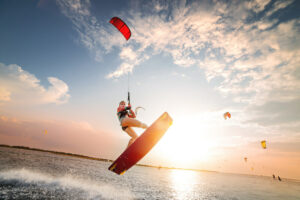Speed, height and finesse. Kiteboarding is THE most exciting and challenging way to surf in the whole diverse surfing universe. Every muscle in use, and every brain cell working to calculate the combined powers of wind and water. Picking the right kiteboard can make all the difference in mastering those waves and experiencing the adrenalin rush of riding them.
Nothing ruins the fun of executing a sport more than getting frustrated over the material. In our comprehensive guide you will find helpful recommendations, kite size wind charts and an easy to understand kiteboard size chart. Picking the perfect match for your body type and skill level might seem like a science for itself.
But if you follow a handful of easy key points, you will be ready to go and choose a board yourself like a professional in no time.
In this article, you will get answers to the following questions:
- Which different kiteboard types are there?
- What size kiteboard do I need?
- Does the wind influence the board size choice?
- What kiteboard size is best for freeriders?
5 Key Aspects – How to Choose the Best Kiteboard Size?
Whether you’re a newbie catching your first wave or seeking an upgrade, choosing the right kiteboard size can make the difference between standing the first try or quitting after a day full of frustration.
Many before you, not even excluding absolute pro surfers, have made the mistake of picking a kiteboard size carelessly or orienting their choice on the wrong factors. You don’t learn driving in a Ferrari. Just because King of the Air Robby Naish surfs on one specific board, it doesn’t make this board a good choice for everyone.
In the following, we will direct you step by step down the road, leading to your personalized dream board.
Here are the most important facts to consider when making your choice:
➀ Your weight
➁ Your skill level
➂ Wind conditions
➃ Your riding style
➄ Board type
➅ Personal Adjustments
Looks easy? Exactly! Get your notepad and pencil ready and off we go checking off our list… Let’s find out what is the best kiteboard size for you.
Check out the bodyboard size and the surfboard size guide.
Step 1: Your Weight
Your weight is one of the most critical factors in determining the size of your kiteboard. The relationship between your weight and the kiteboard size is crucial because it directly affects the board’s buoyancy, stability, and overall performance. Here’s how your weight influences your kiteboard size choice:
Buoyancy and Flotation:
The buoyancy of the kite board is critical for keeping you afloat and maintaining control on the water. Heavier riders require larger boards with more buoyancy to support their weight effectively.
A board that is too small for your weight may sink or struggle to stay afloat, making it challenging to ride comfortably and safely.
Stability
A properly sized kiteboard provides stability on the water. Heavier riders need a larger surface area to distribute their weight and maintain balance.
A board that’s too small may feel unstable, leading to difficulties in maintaining control, especially in choppy or challenging conditions.
Planing and Speed
Planing is the phase when the board skims on the water’s surface before lifting onto a plane. Heavier riders need more surface area to achieve planing efficiently.
A larger board allows for quicker planing, which translates into better speed and performance.
Maneuverability
While larger boards offer stability and buoyancy, they may sacrifice some maneuverability. Lighter riders can afford to use smaller boards that are more responsive and agile, making it easier to perform tricks and turns.
Wind Range
The wind conditions also interact with your weight and board size. Heavier riders can handle stronger winds more effectively with larger boards, while lighter riders may need smaller boards to manage in lighter wind conditions.
Note:
To convert kilograms (kg) to pounds (lb), note that 1 kilogram equals 2.2 pounds. To convert meters (m) to feet (ft), note that 1 meter equals 3.3 feet.
Kiteboard Size Chart
Rider’s Weight Kiteboard Length Kiteboard Width
<55 kg <134 cm 41 cm
56 – 68 kg 134 – 148 cm 41 cm 68 – 81 kg 140-160 cm 43 cm
81 – 95 kg 142 – 165 cm 45 cm
>95 kg 146 – 165 cm 46 cm
Step 2: Your Skill Level
Assess your kitesurfing skill level honestly. If you’re an absolute beginner, you’ll want a board with features that enhance stability and buoyancy. If you have some experience, you might consider a kiteboard that allows for more maneuverability.
Understanding your strengths and areas for improvement builds confidence, as you can approach challenges with a clear understanding of what you can handle and what you need to work on.
Step 3: Wind Conditions
Consider the average wind conditions in your kiteboarding area. In lighter winds, a larger board can help you plane and ride more efficiently. In stronger winds, a smaller board will provide more control.
The most common way to communicate wind conditions is the Beaufort Scale. On a scale from 0 (calm) to 12 (hurricane) the wind speed can be categorized. Since neither zero wind nor a storm would be ideal for kite surfing, we will only focus on the center of the Beaufort Scale.
From a 2 (light breeze, 4 – 6 knots) on the Beaufort Scale, where leaves and small twigs move, and the sea surface becomes moderately rough, up to a 6 (strong breeze, 22 – 27 knots) on the scale, where large branches move, and there are large waves with foam crests. That is the best kite surfing wind window.
As a general categorization, you can differentiate between soft wind, moderate wind and strong winds to adapt your kiteboard size accordingly.
Light Wind (5-10 knots): In light wind conditions, you’ll want a larger kiteboard with more surface area. A larger board provides better flotation, allowing you to get up on the plane and ride efficiently even when the wind is weak.
Moderate Wind (10-20 knots): Moderate wind conditions are ideal for a range of kiteboard sizes, depending on your skill level and riding style. A medium-sized board is suitable for most riders during these conditions, offering a balance between control and maneuverability.
Strong Wind (20+ knots): In strong wind conditions, smaller kiteboards are preferred. A smaller board provides better control and maneuverability, allowing you to handle the higher wind speeds and maintain stability.
Kite Size Wind Chart
Wind range (knots) 5-10 7-12 9-14 10-16 14-20
Rider Weight (kg) Kite size (m²)
40-50 10-11 8-9 6-7 4-5 3
50-60 11-12 9-10 7-8 5-6 3-4
60-70 12-13 10-11 8-9 6-7 4-5
70-80 13-14 11-12 9-10 7-8 5-6
80-90 14-15 12-13 10-11 8-9 6-7
90-100 15-16 13-14 11-12 9-10 7-8
100+ 16-18 14-16 12-14 10-12 8-10
Step 4: Your Riding Style
The choice of kiteboard size in kiteboarding is closely linked to your riding style and preferences. Different kiteboard sizes are designed to enhance specific aspects of your riding experience.
Freeride: Freeride kite boarders typically enjoy cruising, jumping, and performing basic tricks. For this riding style, a medium-sized board with a good balance of length and width is often preferred. It offers stability for cruising and jumping, while allowing some maneuverability for basic tricks.
Freestyle: Freestyle kite boarders focus on advanced tricks, spins, grabs, and jumps. Smaller kiteboards are favored for this riding style, as they provide enhanced maneuverability and responsiveness in the air. A smaller board allows for quicker rotations and precise control during tricks.
Wake style: Wake style kiteboarding involves performing tricks while using kiteboarding-specific features like sliders and kickers, often found in cable parks. Riders who enjoy wake style typically use shorter and wider kiteboards for increased stability on obstacles and in choppy water.
Wave Riding: Wave riding is all about surfing ocean waves using a kite. For this style, kite boarders often choose smaller, surfboard-style kiteboards designed to mimic the feel of traditional surfing. These boards provide the necessary maneuverability and control in the waves.
Big Air and Aerial Tricks: Riders who chase big air and aerial tricks may opt for larger, more buoyant kiteboards. These boards help generate lift for higher jumps and aerial maneuvers, providing more hang time in the air.
Foiling: Foil boarding is a distinct style within kiteboarding. Foil boards are typically larger and longer than standard kiteboards and are designed for use with a hydrofoil. The foil lifts the board out of the water, offering a unique and smooth riding experience.
Race and Speed: Kite boarders who compete in races or enjoy high-speed runs may choose specialized race boards. These boards are typically longer, narrower, and designed for maximum speed and upwind performance.
Step 5: Board Type
Just as no kite surfer is like the other, there are various shapes of boards and kites for any specific needs and riding styles. In the following, we will introduce the most common shapes of kiteboards and how to judge the kiteboard size accordingly.
The Foil Boards: Foilboards are designed explicitly for foiling, and their size and shape are determined by the foil setup being used. Foilboard sizes can vary significantly depending on foil wing size and rider preference.
The Kitesurf Boards/Wave Kiteboards: The optional use of a foot strap makes this kind of kite board ideal for riders who wish to hit the surf and the waves, go for big airs, or simply cruise around unhooked.
Objectively speaking, the differences between a normal surfboard and the kiteboard are minimal. The only differentiation is, that a kite surfboard is generally smaller, thinner, and narrower than a standard shortboard.
The Light Wind Kiteboards: With its nearly perfectly rectangular shape, the light wind kiteboard offers a big surface area, allowing the rider to plane in marginal winds.
Generally speaking, this board is slightly flatter, lighter, and wider than an average twin-tip.
Kiteboards designed for light wind conditions often come with a higher price tag compared to standard twin-tips, and they are the preferred choice for riders with greater weight.
The Twin-Tip Kiteboards: The twin-tip kiteboard is widely popular and versatile, suitable for a wide range of kiteboarding styles. Resembling a traditional wakeboard, it typically comes equipped with foot straps and pads for a secure grip.
Many twin-tip models feature a concave bottom design and channels that direct water flow, enhancing their speed capabilities. Available with flat, moderate, or high rocker options, the twin-tip boasts either a straight or curved outline with square or rounded tips.
It is a preferred choice for kiteboarding enthusiasts who enjoy freestyle, freeride, race, and wakestyle disciplines.
Step 6: Personal Adjustments
We advise going smaller than the size given when:
- you want to ride in strong winds and prefer to ride powered
- you have a more playful/maneuverable riding style
- you are comparatively small for your weight
We advise going bigger than the size given when:
- you are riding with boots
- you prefer more comfort and less impact on your knees
- you are looking for better upwind abilities
- you are often riding in low wind conditions, around 15kn
Dos and Don’ts
So it’s time to decide now. Making a decision about your first surfboard can be overwhelming with all the information. Here’s a concise summary of the most common mistakes to avoid and helpful tips to guide you:
- Do Prioritize Stability Over Performance: Focus on stability and ease of use rather than advanced features or performance characteristics that may not be necessary for beginners.
- Do Rent or Borrow Before Buying: Test different types of boards through rentals or borrow from friends to get a feel for what suits you best before making a purchase.
- Do Seek Professional Advice: Consult experienced surfers or professionals at surf shops to help you find a suitable board based on your skill level, size, and local wave conditions.
- Don’t Rush to Advanced Boards: Avoid transitioning to a more advanced board too quickly; ensure you have a solid foundation of basic skills first.
- Don’t Underestimate the Learning Curve: Learning to kite surf takes time and practice. Be patient and don’t expect immediate mastery.
- Don’t Get Overwhelmed by Aesthetics: While aesthetics are important, focus on the board’s functionality and suitability for your skill level.
Remember, there is absolutely no embarrassment in being a beginner. Take your time, select a skill appropriate surfboard and the surfer community will be celebrating every little step you take, becoming better and better.
Conclusion: What is the right kiteboard size for you?
Choosing your perfect wave companion is never an easy choice. In fact, it is a pivotal decision that can shape your entire kite surfing experience. Through the waves of information and advice, we’ve navigated the seas of options, highlighting the essential factors and considerations.
From understanding the nuances of board size and shape to grasping the significance of stability and buoyancy, you’ve gained insight into the art of selecting your perfect kiteboard size. With the help of a kiteboard size chart and a kite size wind chart, the process gets as easy as possible.
And by embracing honesty, patience, and the willingness to learn, the best foundation for your kite surfing journey has already been set. Rest your decision on the foundation of safety, stability, and trust in the learning curve, and the right kiteboard size should be whatever kiteboard you decided on.
FAQ – Most asked question about kiteboard size
Depending on your own height and weight, you will want to adjust the kite board’s length and volume. Kiteboard sizes range from 134 cm up to 165 cm. The bigger the kite board, the easier it should be to keep balance, but also the less maneuverability it offers.
Improving your kiteboard with a customized fiber is not necessarily needed, but can bring great advantages. The fiber makes the kite board more shock-resistant and longer lasting. It improves the comfort, absorbs the impact of high impact landings much better, and can also help heavier riders if they want to maintain the board size but need more stiffness.
Expensive does not equal better! Many kiteboards that pro athletes use are not suited for surf newbies. Also, if you want to level up, you most likely will want to switch to a different board. So maybe better start by renting a good kiteboard kit for beginners and invest later in your kite surfing career in a longer lasting kite surf companion.
The right choice for a kiteboard size should prioritize buoyancy, stability, and safety. By picking a kite board based on your skill set, your preferred riding style and your body type, those demands should be met. Yet, everybody can adjust their choice according to their personal preferences.







